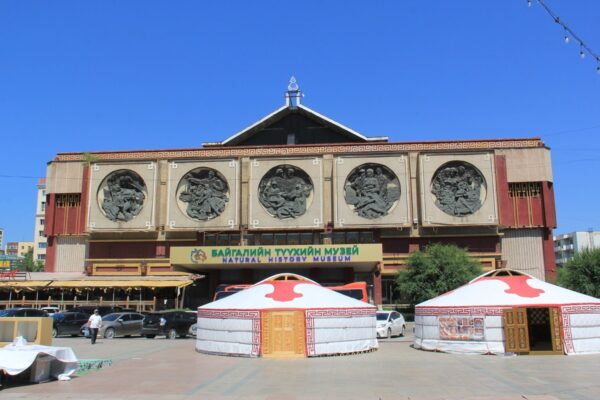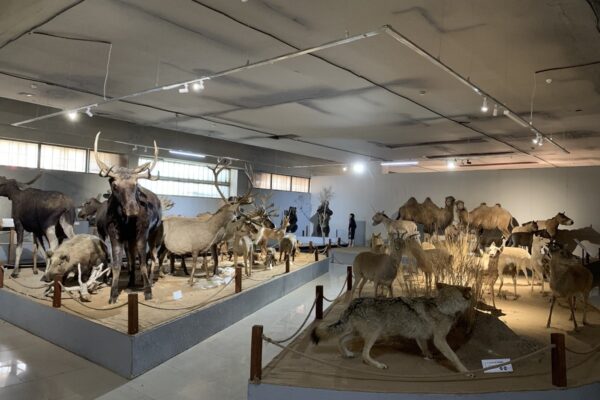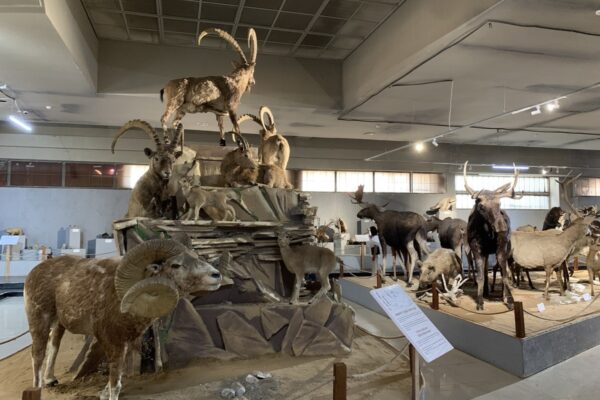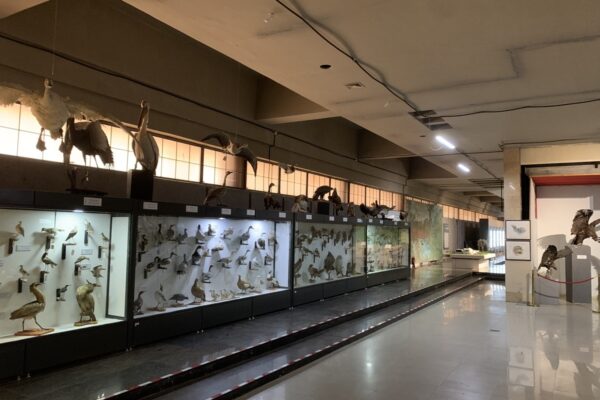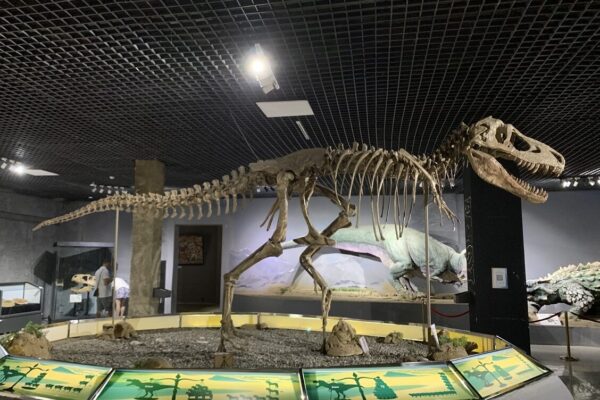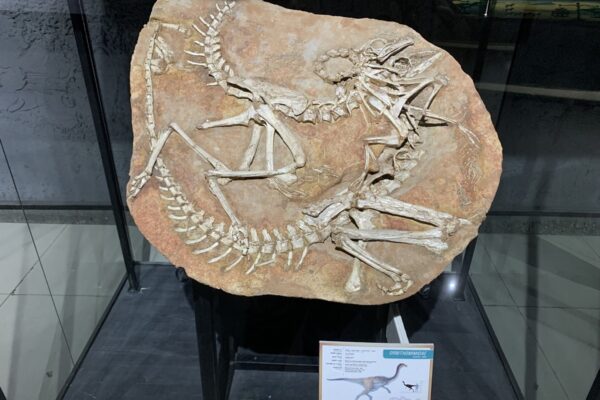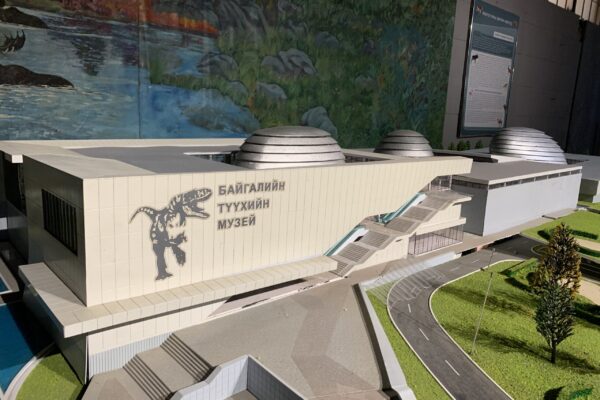The Mongolian Museum of Natural History, founded in 1924, is a significant landmark in Mongolia. Initially called the “National Museum,” it moved to its present location in 1930 and was renamed the “State Central Museum” from 1956 to 1991. Since 1992, it has been known as the “Mongolian Museum of Natural History “. The museum showcases various exhibits related to artifacts and anthropology, making it a must-visit destination for history enthusiasts.
As you enter the museum, you will notice two stone lions at the entrance, originally located at the front yard of the Yellow Palace of Bogd Khan. These lions were brought to the museum in 1954 on the initiative of scientist O. Namnandorji. However, in 2014, the Ministry of Culture, Sports, and Tourism decided to demolish the Mongolian Museum of Natural History and build a new building, temporarily suspending its activities.
The Geography Hall
Among the museum’s many attractions, the Geography Hall stands out for its impressive display of Mongolia’s geography. It includes the first map, “Simukov’s Green Card,” marking routes traveled by foreign scientists who studied Mongolia before the revolution, photos showing the distribution of fish and mammals, and the “Aj Bogd” meteorite, weighing 582 kg with 92% iron, and the iron meteorite “Manlay,” weighing 166.8 kg.
The Hall showing the origin of life
The Hall showing the origin of life is another fascinating exhibit, showcasing the chronology of life on earth, starting from 4 billion years ago, displayed on the wall. In the adjacent glass case, visitors can find soil and rock samples from that period.
The Astronomy Hall
The Astronomy Hall is a must-visit for space enthusiasts and features materials used by J. Gurragchaa, the first Mongolian and Asian astronaut, J. Tserendeleg, a meteorologist who researched at the South Pole, and G. Usehbayar, the first Mongolian to climb Everest. The country conducted research on the South Pole, which lasted from 1972 to 1974 and started climbing Everest on April 28, 2005, finally reaching the summit on May 30 at 2 p.m. Ulaanbaatar time.
The Hall of Geology and Minerals
The Hall of Geology and Minerals is yet another impressive exhibit, showcasing Mongolia’s abundant minerals. Visitors can find samples of fluorspar, graphite, lead, tin, asbestos, fat stone, mica, crystal, ore, phosphorus, sulfur, volcanic rock, marble, chert, and precious stones such as salt, garnet, green garnet, water crystal, chungchignorov, agate, turquoise, lapis lazuli, and jade.
The Bird Chamber
The Bird Chamber is a treat for birdwatchers, showcasing a total of 469 bird species recorded in Mongolia, including large predatory birds such as eagles, vultures, falcons, pelicans, storks, swans, spoonbills, white cranes, coots, geese, ducks, seagulls, and other water birds, as well as prairie and forest birds. The entrance hall also displays the horns of animals listed in the Mongolian Red Book, such as argal sheep, ibex, elk, deer, and gazelle.
The Hall of Paleontological Artifacts
The Hall of Paleontological Artifacts is a highlight of the museum, consisting of four main chambers, where visitors can see the general appearance of nature tens of millions of years ago. The exhibit includes fossilized wood, fossilized skin of a spiny-billed dinosaur, armored, toothless but carnivorous, flying lizards considered to be the ancestor of birds, thick-skinned, ostrich-shaped carnivore, giant carnivorous Tarbosaurus weighing 2-3 tons, fossils such as the tailbone of the herbivorous Sauropod and the enormous front claw of Deinocherus.
The Botanical Hall
The Botanical Hall is another exhibit visitors should not miss, showcasing Mongolia’s native plant regions, classified as desert, barren steppe, steppe, forest-steppe, mountain taiga, and high mountain vegetation. It displays dried plants classified as medicinal, essential oil, tanning, dye, and edible plants.
Chamber of Insects
Chamber of Insects is a fascinating exhibit showcasing 13,000 species of insects in 270 genera in Mongolia. The room displays species of beetles, grasshoppers, scale insects, fleas, butterflies, bats, insects, and spiders. Overall, the Mongolian Museum of Natural History is a treasure trove of knowledge, making it a must-visit destination for people who love natural history, geology, and anthropology.
The Museum of Natural History in Mongolia is a treasure trove of fascinating exhibits showcasing the country’s diverse wildlife, from fish and amphibians to mammals and birds.
The Hall of Fish, Amphibians, and Reptiles
The Hall of Fish, Amphibians, and Reptiles boasts a stunning collection of over 76 species of fish, including the Darkhad white fish, Khuvsgul omul, Siberian sturgeon, mullet, roach, grayling, pike, perch, and pike. Visitors can also marvel at representatives of more than 20 species of lizards, reptiles, and amphibians on display.
The Camel Showroom
The Camel Showroom is a must-see exhibit, featuring camel hair handicrafts, camel-themed postcards, signs, posters, researchers’ collections and presentations, camel skeletons, stuffed camels, paintings, and calligraphy. Did you know that humans have been domesticating camels for 5,000 years, and camel races were held 2,000 years ago during the Hun Empire?
The Hall of Wild Horse
The Hall of Wild Horse is another fascinating exhibit, showcasing the history and preservation of the Mongolian horse. Russian scientist Prezhevalsky discovered that the horse is the ancestor of the Mongolian horse, and visitors can learn about the joint Mongolian-Holland horse introduction project that has been implemented since 1992. The project has helped to reintroduce the Mongolian horse, which became extinct in the 1960s, with features such as skin, liquid tail, grazing against the wind, very alert sorghum, sorghum, etc.
The Theory Room for Birds and Mammals
The Theory Room for Birds and Mammal is a great educational exhibit, featuring demonstrations on the embryology and development of mammals. Secondary school students are given hands-on lessons to learn more about these fascinating creatures.
The Hall of Forest Taiga Animals
The Hall of Forest Taiga Animals is a must-see exhibit, showcasing the diverse range of mammals in Mongolia. Visitors can marvel at stuffed animals such as elk, deer, woodchuck, brown bear, moose, beaver, sable, rock marten, skunk, elk, and reed bear, among others.
The Chamber of Animals of the Gobi Region
The Chamber of Animals of the Gobi Region is a fascinating exhibit, showcasing the unique wildlife of the Gobi Mountains. Visitors can marvel at stuffed animals such as wild boar, ibex, leopard, black-tailed deer, gazelle, starling hedgehog, and horses. In addition to the animals, visitors can also see the working tools used by ancient herds of humans and human skeletons from the time of the umbilical cord fusion. There is even an exhibit where the bones are compared to modern human skeletons.
Finally, visitors can’t miss the stunning leatherwork “Tarbosaurus” on the upper wall of the main staircase. Created and decorated in 2006, the artwork features more than 20 sheep and goat skins and 9 horse skins, making it one of the largest leather craftworks in Asia at that time. Tarbosaurus is the largest terrestrial dinosaur, and three complete bones have been found. These artifacts are stored in the Museum of Natural History in Ulaanbaatar, Moscow, and New York.

